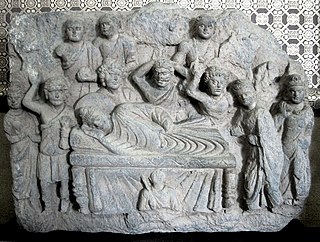Related Research Articles

The Eightfold Path is an early summary of the path of Buddhist practices leading to liberation from samsara, the painful cycle of rebirth, in the form of nirvana.
Theravāda is the most commonly accepted name of Buddhism's oldest existing school. The school's adherents, termed Theravādins, have preserved their version of Gautama Buddha's teaching or Buddha Dhamma in the Pāli Canon for over two millennia.
In Buddhism, the term anattā or anātman refers to the doctrine of "non-self" – that no unchanging, permanent self or essence can be found in any phenomenon. While often interpreted as a doctrine denying the existence of a self, anatman is more accurately described as a strategy to attain non-attachment by recognizing everything as impermanent, while staying silent on the ultimate existence of an unchanging essence. In contrast, Hinduism asserts the existence of Atman as pure awareness or witness-consciousness, "reify[ing] consciousness as an eternal self."
In Buddhism, the three marks of existence are three characteristics of all existence and beings, namely aniccā (impermanence), dukkha, and anattā. That humans are subject to delusion about the three marks, that this delusion results in suffering, and that removal of that delusion results in the end of dukkha, is a central theme in the Buddhist Four Noble Truths and Noble Eightfold Path.
The English term enlightenment is the Western translation of various Buddhist terms, most notably bodhi and vimutti. The abstract noun bodhi, means the knowledge or wisdom, or awakened intellect, of a Buddha. The verbal root budh- means "to awaken," and its literal meaning is closer to awakening. Although the term buddhi is also used in other Indian philosophies and traditions, its most common usage is in the context of Buddhism. Vimukti is the freedom from or release of the fetters and hindrances.
Rebirth in Buddhism refers to the teaching that the actions of a sentient being lead to a new existence after death, in an endless cycle called saṃsāra. This cycle is considered to be dukkha, unsatisfactory and painful. The cycle stops only if moksha (liberation) is achieved by insight and the extinguishing of craving. Rebirth is one of the foundational doctrines of Buddhism, along with karma, Nirvana and liberation. Rebirth was however less relevant among early Buddhist teachings, which also mentioned the beliefs in an afterlife, ancestor worship, and related rites. The concept varies among different Buddhist traditions.

In Buddhism, parinirvana is commonly used to refer to nirvana-after-death, which occurs upon the death of someone who has attained nirvana during their lifetime. It implies a release from Saṃsāra, karma and rebirth as well as the dissolution of the skandhas.
Ātman, attā or attan in Buddhism is the concept of self, and is found in Buddhist literature's discussion of the concept of non-self (Anatta).
Saṅkhāra is a term figuring prominently in Buddhism. The word means 'formations' or 'that which has been put together' and 'that which puts together'.

Buddhism, also known as Buddha Dharma and Dharmavinaya, is an Indian religion or philosophical tradition based on teachings attributed to the Buddha. It originated in present-day North India as a śramaṇa–movement in the 5th century BCE, and gradually spread throughout much of Asia via the Silk Road. It is the world's fourth-largest religion, with over 520 million followers (Buddhists) who comprise seven percent of the global population.

Buddhist ethics are traditionally based on what Buddhists view as the enlightened perspective of the Buddha. The term for ethics or morality used in Buddhism is Śīla or sīla (Pāli). Śīla in Buddhism is one of three sections of the Noble Eightfold Path, and is a code of conduct that embraces a commitment to harmony and self-restraint with the principal motivation being nonviolence, or freedom from causing harm. It has been variously described as virtue, moral discipline and precept.

Saṃsāra in Buddhism and Hinduism is the beginningless cycle of repeated birth, mundane existence and dying again. Samsara is considered to be dukkha, suffering, and in general unsatisfactory and painful, perpetuated by desire and avidya (ignorance), and the resulting karma.
Avidyā in Buddhist literature is commonly translated as "ignorance". The concept refers to ignorance or misconceptions about the nature of metaphysical reality, in particular about the impermanence and anatta doctrines about reality. It is the root cause of Dukkha, and asserted as the first link, in Buddhist phenomenology, of a process that leads to repeated birth.
Karma is a Sanskrit term that literally means "action" or "doing". In the Buddhist tradition, karma refers to action driven by intention (cetanā) which leads to future consequences. Those intentions are considered to be the determining factor in the kind of rebirth in samsara, the cycle of rebirth.

Hinduism and Buddhism have common origins in the culture of Ancient India. Buddhism arose in the eastern Ganges culture of northern India during the "second urbanisation" around 500 BCE. Hinduism developed out of the ancient Vedic religion, adopting numerous practices and ideas from other Indian traditions over time. Both religions have many shared beliefs and practices, but also pronounced differences that have led to much debate.

Nirvana is "blowing out" or "quenching" of the activities of the worldly mind and its related suffering. Nirvana is the goal of the Hinayana and Theravada Buddhist paths, and marks the soteriological release from worldly suffering and rebirths in saṃsāra. Nirvana is part of the Third Truth on "cessation of dukkha" in the Four Noble Truths, and the "summum bonum of Buddhism and goal of the Eightfold Path."
Skandhas (Sanskrit) or khandhas (Pāḷi) means "heaps, aggregates, collections, groupings". In Buddhism, it refers to the five aggregates of clinging, the five material and mental factors that take part in the rise of craving and clinging. They are also explained as the five factors that constitute and explain a sentient being’s person and personality, but this is a later interpretation in response to sarvastivadin essentialism.
Bhavaṅga, also bhavanga-sota and bhavanga-citta is a passive mode of intentional consciousness (citta) described in the Abhidhamma of Theravada Buddhism. It is also a mental process which conditions the next mental process at the moment of death and rebirth. It is an exclusively Theravada doctrine that differs from Sarvastivadin and Sautrantika theories of mind, and has been compared to the Mahayana concept of store-consciousness.
Luminous mind is a Buddhist term which appears only rarely in the Pali Canon, but is common in the Mahayana sūtras and central to the Buddhist tantras. It is variously translated as "brightly shining mind", or "mind of clear light" while the related term luminosity is also translated as "clear light" or "luminosity" in Tibetan Buddhist contexts or, "purity" in East Asian contexts.

Mahāyāna is a term for a broad group of Buddhist traditions, texts, philosophies, and practices. Mahāyāna Buddhism developed in ancient India and is considered one of the three main existing branches of Buddhism. Mahāyāna accepts the main scriptures and teachings of early Buddhism but also recognizes various doctrines and texts that are not accepted by Theravada Buddhism as original. These include the Mahāyāna sūtras and their emphasis on the bodhisattva path and Prajñāpāramitā. Vajrayāna or Mantra traditions are a subset of Mahāyāna which makes use of numerous tantric methods Vajrayānists consider to help achieve Buddhahood.
References
- ↑ "Peter Harvey | University of Sunderland - Academia.edu".
- ↑ 2nd edition preface, page xv
- ↑ Article title [ bare URL PDF ]
- ↑ Harvey, Peter (13 September 2013). The Selfless Mind: Personality, Consciousness and Nirvana in Early Buddhism. Routledge. ISBN 9781136783364 – via Google Books.
- 1 2 Peter Harvey Biography, Academia, University of Sunderland
- ↑ Peter Harvey, Secular Buddhist Association
- ↑ "Peter Harvey - University of Sunderland - Academia.edu". sunderland.academia.edu.
- ↑ An Introduction to Buddhism, p7